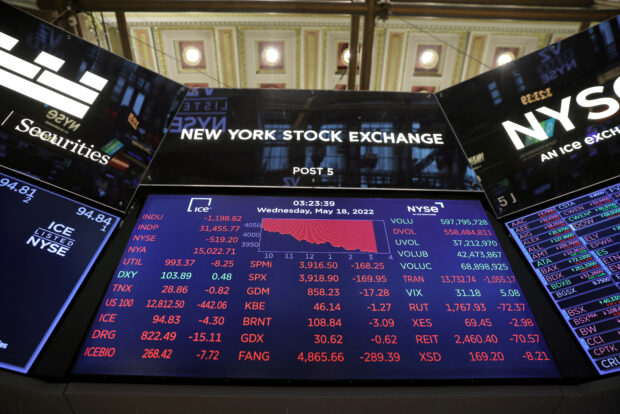
A monitor displays stock market information on the trading floor at the New York Stock Exchange (NYSE) in Manhattan, New York City, U.S., May 18, 2022. REUTERS/Andrew Kelly/File photo
LONDON – Red October rumbled on in world markets on Friday as the sight of U.S. government bonds yields hitting 5 percent for the first time since 2007 amid an increasingly threatening conflict in the Middle East left investors searching for safety.
The traditional driver of world borrowing costs – the 10-year U.S. Treasury yield – had retreated to 4.93 percent but with oil back above $93 a barrel and Israel looking like it was gearing up for a full-scale invasion of Gaza, the mood was fraught.
Europe’s share markets dropped 1 percent. Asia stocks had fallen to an 11-month low overnight and futures markets pointed to another slip on Wall Street, which has lost 2 percent over the last two days.
The Bank of Japan had intervened in its bond markets too as the 10-year JGB yield touched a decade high, while the scramble for safety pushed gold to a 3-month top and kept both the dollar and Swiss franc well supported.
READ: Bank of Japan intervenes as 10-year JGB yield hits fresh decade peak
“The fact that there was little pullback in bond yields in the past 48 hours despite the S&P 500 slipping over 2 percent and the VIX Index closing at over 21 for the first time since March is very disconcerting in my view,” RBC Capital strategist Alvin Tan said, referring to one of main global market fear gauges.
A slump in Tesla shares after Elon Musk warned of demand worries wasn’t helping the mood either in Europe where shares were facing a 3-percent loss for the week and borrowing costs were heading for their steepest weekly rise since July.
The European Central Bank meets next week and is expected to keep its rates on hold after 10 consecutive increases but for now markets were focused on other issues.
Federal Reserve chief Jerome Powell had said on Thursday that he agreed “in principle” that the recent jump in bond yields might “at the margin” lessen the need for more rate hikes, but also stressed the strength of the economy.
Submerging markets
The Middle East troubles and rising global borrowing costs meant emerging market stocks were at an 11-month low as was MSCI’s main Asia Pacific index.
Tokyo’s Nikkei had finished 0.5 percent lower on the day and -3.2 percent for the week which only just short of being its worst week of the year.
Data out of Japan had showed core inflation in September slowed below the 3 percent threshold for the first time in over a year.
READ: Japan’s core inflation slows below 3% for first time in over a year
China’s blue chips and Hong Kong’s Hang Seng both dropped 0.7 percent. China on Friday had held its benchmark lending rates steady following some signs of stabilization in the economy this week.
The U.S. dollar was within a hair’s breadth of the closely watched 150 yen level at 149.84 yen. It was up 0.1 percent against its main global peers at 106.34, not too far from an 11-month top of 107.34 hit in early this month.
Quincy Krosby, chief global strategist at LPL Financial, said focus was intensifying on the U.S. fiscal deficit because of the larger defence funding needs for Washington.
U.S. President Joe Biden on Thursday asked Americans to spend billions more dollars to help Israel fight Hamas, with mounting expectations that Israeli forces will mount a ground invasion of Gaza imminently.
A U.S. Navy warship intercepted three cruise missiles and several drones launched by the Iran-aligned Houthi movement from Yemen potentially toward Israel. A U.S. base in Iraq had also came under attack Washington said.
“There are several reasons why investors would want to sell this market, while very few to buy. That’s what we’ve seen today as risk sells off,” said Kyle Rodda, senior financial market analyst at capital.com.
“To put it in simplest terms, market participants don’t want to be carrying risk into the weekend when hostilities could erupt.”
Gold prices scaled a fresh 3-month peak of $1,990 per ounce, the highest since late July, as investors sought safe-haven assets in the turmoil.
READ: Oil on track for second week of gains on Gaza contagion fears
Oil prices were headed for the second weekly gain, due to fears of an escalating regional conflict in the Middle East, which would disrupt supplies.
U.S. crude jumped 1 percent to $90.30 per barrel and Brent was at $93.50, up 1.2% on the day.

